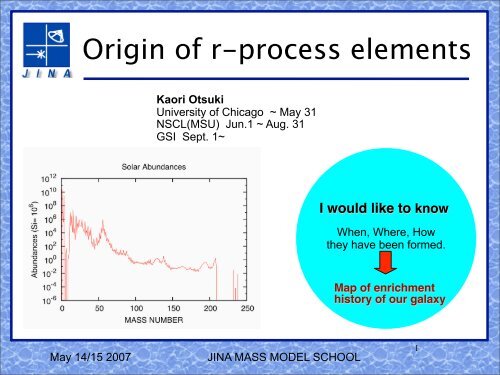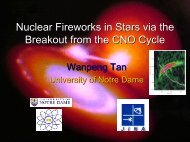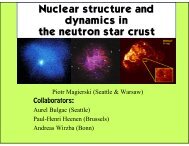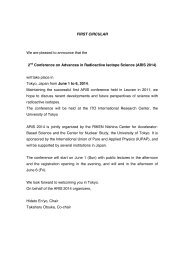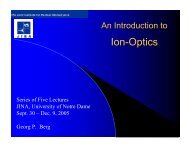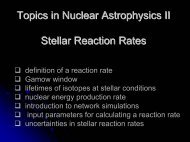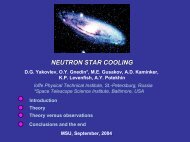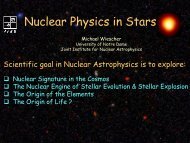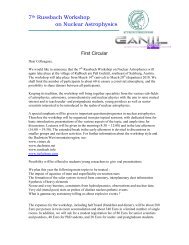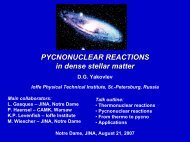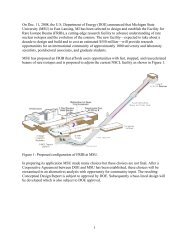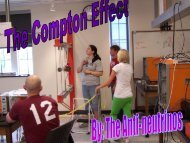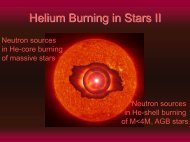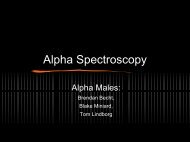Origin of r-process elements
Origin of r-process elements
Origin of r-process elements
Create successful ePaper yourself
Turn your PDF publications into a flip-book with our unique Google optimized e-Paper software.
<strong>Origin</strong> <strong>of</strong> r-<strong>process</strong> <strong>elements</strong><br />
Kaori Otsuki<br />
University <strong>of</strong> Chicago ~ May 31<br />
NSCL(MSU) Jun.1 ~ Aug. 31<br />
GSI Sept. 1~<br />
I would like to know<br />
When, Where, How<br />
they have been formed.<br />
Map <strong>of</strong> enrichment<br />
history <strong>of</strong> our galaxy<br />
May 14/15 2007<br />
JINA MASS MODEL SCHOOL<br />
1
R-<strong>process</strong> study<br />
Theoretical Study<br />
(site(s Assume Astrophysical<br />
e.g. Type II SNe, Neutron Star Mergers, etc.<br />
+<br />
Chemical Evolution models<br />
Experiments<br />
Obtain ρ(t), T(t), Lν(t), initial abundance<br />
Simulation, analytic model...<br />
+<br />
Network calculation<br />
Final abundances<br />
Mass Model<br />
Beta-decay, fission,<br />
(n,γ),<br />
charged current reactions<br />
Neutrino interactions<br />
Observations<br />
Metal poor stars<br />
Globular clusters<br />
2
Network code<br />
<br />
<br />
Full dynamical network code<br />
− based on Meyer et al. 1994, modified by Terasawa,<br />
Orito, & Otsuki (1997, 2001, 2003)<br />
− differential equations for more than 4000 nuclide<br />
− start from free n&p<br />
<br />
<br />
solve seed production and r-<strong>process</strong> at the same time<br />
include neutron-capture <strong>of</strong> light <strong>elements</strong> (Sasaqui et al.<br />
2005)<br />
Nuclear data<br />
<br />
<br />
MASS---Hilf, HFB9, FRDM03, FRDM95<br />
Beta-decay---Klapdor, FRDM03<br />
No Consistent data set is<br />
archived yet!<br />
(n,γ)---HFB9, Hilf, FRDM95(up to Bi)<br />
3
Astrophysical site for the ‘main’ r-<strong>process</strong><br />
Dominant Candidate<br />
Neutrino-driven wind in SNe II<br />
SN1987A<br />
S~400<br />
Ye~0.45<br />
τ dyn ~ 0.1sec<br />
Neutron star mergers<br />
Simulation <strong>of</strong> NS mergers<br />
(from Hayden planetarium)<br />
Prompt explosion <strong>of</strong> low mass supernovae<br />
?<br />
ONeMg<br />
S~15<br />
Ye~0.2<br />
τ dyn ~ 0.1sec<br />
S
Theoretical calculation II (Wilson et al.<br />
2006)<br />
Wilson’s new simulation(2006)<br />
<br />
<br />
<br />
M=20M progenitor mass<br />
Improved EOS<br />
Improved numerical method<br />
Entropy~500k<br />
timescale ~0.1sec
Theoretical calculation II (Wilson et al.<br />
2006)<br />
Wilson’s new simulation(2006)<br />
<br />
<br />
<br />
M=20M progenitor mass<br />
Improved EOS<br />
Improved numerical method<br />
Entropy~500k<br />
timescale ~0.1sec
Theoretical calculation II (Wilson et al.<br />
2006)<br />
Wilson’s new simulation(2006)<br />
<br />
<br />
<br />
M=20M progenitor mass<br />
Improved EOS<br />
Improved numerical method<br />
Entropy~500k<br />
timescale ~0.1sec
Theoretical calculation II (Wilson et al.<br />
2006)<br />
Wilson’s new simulation(2006)<br />
<br />
<br />
<br />
M=20M progenitor mass<br />
Improved EOS<br />
Improved numerical method<br />
Entropy~500k<br />
timescale ~0.1sec
Theoretical calculation II (Wilson et al.<br />
2006)<br />
Wilson’s new simulation(2006)<br />
<br />
<br />
<br />
M=20M progenitor mass<br />
Improved EOS<br />
Improved numerical method<br />
Entropy~500k<br />
timescale ~0.1sec
Theoretical calculation II (Wilson et al.<br />
2006)<br />
Wilson’s new simulation(2006)<br />
<br />
<br />
<br />
M=20M progenitor mass<br />
Improved EOS<br />
Improved numerical method<br />
Entropy~500k<br />
timescale ~0.1sec
Heavy <strong>elements</strong> are formed<br />
at the later stage <strong>of</strong> wind.
Current & near future works<br />
<br />
<br />
<br />
<br />
Weak r-<strong>process</strong> in neutrino-winds<br />
− Can we reproduce HD122563 pattern?<br />
Role <strong>of</strong> Fission recycling in main r-<strong>process</strong><br />
− Does it explain an universal abundance pattern?<br />
Suitable environment for the main r-<strong>process</strong><br />
− Conditions to reproduce observed Th/Eu & Y,Zr/Eu<br />
Other collaborations<br />
(data − R-<strong>process</strong> in Type II SNe (based on Simulation<br />
− New reaction rates from experiments<br />
− Observation <strong>of</strong> neutron-capture <strong>elements</strong> in GCs<br />
− fission mass fragment<br />
− neutrino absorption in r-<strong>process</strong><br />
7


